A Dialectic of Power-play: A Dialogue Between Political and Apolitical Cartoons and the Purpose of Evoking Laughter
Abstract
In the culture of modern semiotics and western thoughts a cartoon can often be defined as one kind of drawing, that may be representational or may have symbolic significance; that sometimes generates an ironic, witty or humorous view regarding life and society. Although cartooning, as we perceive it today as a part of contemporary visual art, is an extension of caricature, it is something that spontaneously evolves to a higher plane. At some point of seventeenth century, we notice a significant emergence of bifurcation of two avenues that led to the development of two mutually exclusive but at times related sub-genres of ‘caricature’ (or distorted representation of individual) and ‘cartooning’ (or a rather distorted representation of ideas, issues, and situations). This paper concerns itself to emphasize the comparative differentiation of the very purpose that gives birth to political cartoons and other forms of apolitical cartoons, relying on the specifications of the subject matter and the space it caters to. Furthermore, this paper will engage in a discourse reasoning the tendency of political cartoons making use of a different flavour of humour. Also, this paper endeavours to sketch out the intellectual workings behind cartooning with meticulous attention to political cartoons figuring out the difference between political and apolitical cartoons in respect of evoking laughter and also fulfilling other purposes.
Keywords: Humour, Satire, Caricature, Symbol, (a)political cartoon, laughter
Laughter, a precious boon for human civilization, itself being the proof of its own importance, is an essential part of human life and culture. Various feelings like happiness, sorrow, delight, pain etc. of different species of living beings are seen through the instant physical changes of different organs of the body. Each and every living being is conscious of the presence of such an ability. From the very beginning of the time of creation, in case of human beings, these aforesaid feelings are expressed through the physiological activities. In the same way, when the feelings of happiness, delight and complacency are bloomed in the life of human beings, we can call it laughter. So, we can say that laughter, one kind of physical reaction in humans and some other species of primate, is one part of behavior regulated by the brain and in that process, it creates rhythmical and mostly audible contractions of the diaphragm and other parts of the respiratory system. Hence, we can call laughter a ‘speaking in tongues’ which comes spontaneously being an unconscious response to the various social and linguistic signs. Laughter generates energy and excitement for future work from the innermost core of the heart. Nobody can deny the necessity of laughter in practical life as it brings positive vibes and spontaneity in human life. In the words of Sean O’Casey, “Laughter is wine for the soul—laughter soft, or loud and deep, tinged through with seriousness—the hilarious declaration made by man that life is worth living” (Sutton).
Before entering into the discussion of cartooning and laughter, let’s have a look at the theoretical discussion of laughter which enforced great literary figures to put their views. Various thinkers like Plato, Aristotle and others have their opinions, either positive or negative, about laughter. J. C. Gregory in his essay “Some Theories of Laughter” quite methodically described some important views of some famous figures about laughter as he wrote, “Laughter, Plato seems to have thought, inclines to immediacy and the ridiculous to buffoonery” while on the other hand, “Socrates specifies among the sources of laughter the weak and impotent who are thereby ridiculous and the misfortunes of friends which excite joy through envy” (332). But, at the same time Socrates does not deny the nature of laughter and its important useful function when he expressed his view to Protarchus, “a jest may sometimes pleasantly interrupt earnest” (qtd. in Gregory 331) but Plato was only bothered about the inelegant elements of laughter. Again “Bain thought ‘a sudden stroke of superiority’ is one of the most certain ‘causes of the outburst of laughter’ and continued the traditional ungracious character which Hobbes had described as a ‘sudden glory arising from sudden conceptions of some eminency in ourselves, by comparison with the infirmities of others'’” and on the other hand, which “Descartes had singled out as the hate that, in the absence of wonder, is necessary for joy to excite laughter” (Gregory 332-332). Again, Coleridge commented that Aristotle identified the laughable as “consisting of, or depending on, what is out of its proper time and place, yet without danger or pain” (qtd. in Gregory). According to Leigh Hunt, “The breath recedes, only to reissue with double force; and the happy convulsion which it undergoes in the process is laughter” (qtd. in Gregory 331).
In case of evoking laughter there should have the presence of a stimulant which would have enough potential to compel us to laugh to our hearts content. Cartoons are one of those stimulants. Cartoons, one kind of drawing, either symbolic or representational, that generates a satirical, witty or humorous idea, also can evoke laughter and helps us to relieve ourselves from stress. Although, nowadays cartooning is perceived as a part of contemporary visual art, it is a product of caricature. At some point of 17th century, we notice a significant emergence of bifurcation of two avenues that led to the development of two mutually exclusive but at times related sub-genres of ‘caricature’, or distorted representation of individual in which certain characteristics are exaggerated in order to evoke laughter and ‘cartooning’, or a rather distorted representation of ideas, issues and situations intended for satire and humour. In the modern times, a cartoon’s significance lies in its sketchy style which is intended to influence public views in respect of some matters or persons. At the same time cartoon is broadly used for the sake of amusement as it creates humorous effect. So, it must not be denied that cartoons and laughter share a close relationship. Cartoons produce laughter with the help of a sign system and proper use of modern techniques. More importantly, if we look at some of the most important features of cartoons, it must be noted that cartoons exhibit things symbolically using simple objects or symbols which stand for larger concepts or ideas. Suppose, a cartoonist tries to sketch the authoritative aggression prevailing in a country and s/he symbolically uses the body of a beast and the head of the supreme ruler of that country in a cartoon. So, the symbolic significance of the cartoon is highly interesting as the inclusion of the body of the beast indicates the beast-like cruelty of the figure who is in authority and who can even exploit the other countries. The authoritative nature of the ruler is satirically attacked and at the same time, the viewers enjoy the humorous presentation and realize the main idea behind it. Through the medium of cartooning, a complex realistic idea gets the proper medium of expression with the help of analogy. It takes a very little space to express a large idea, providing people critical information about life and society. Cartoons have the power to convey light hearted, humorous, mocking, savage or sympathetic messages about numerous ideas of society, culture, environment, events, people etc. Cartoonists invent various types of caricatures using their own style to attract thousands of minds easily to a certain issue. Along with symbolic significance, a cartoon may fulfil other necessary duties and they can be one kind of true artistic invention. One example of such an invention is Fantasmagorie, “the world’s first fully animated cartoon created by Emile Cohl in the traditional hand-drawn animation style” which came to win thousands of hearts in 1908 as a tribute to Incoherent Art Movement of France and also it influenced many avant-garde art movements of later times (“Fantasmagorie''). This animated film is “a brief line animation in which a mysterious puppet, Pierrot or fantoche, and his environment change seamlessly. Flowers become bottles become a cannon; an elephant becomes a house; Pierrot becomes a bubble, a hat, a valise,” writes Chris Gehman, and Steve Reinke in the book The Sharpest Point: Animation at the End of Cinema (“Fantasmagorie''). The following picture (Figure 1) is a drawing from Fantasmagorie where “the most striking sequence is a character sitting at the cinema behind a woman with a huge pineapple-like feathery hat which he then proceeds to rip apart layer after layer” and the next picture (Figure 2) shows how “in a stream of consciousness style, Cohl's hand sketching the characters is also included in some of the frames'' (Fantasmagorie”).
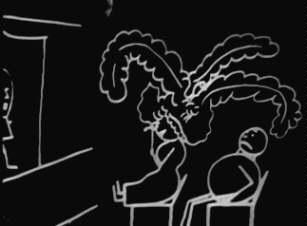
Figure 1
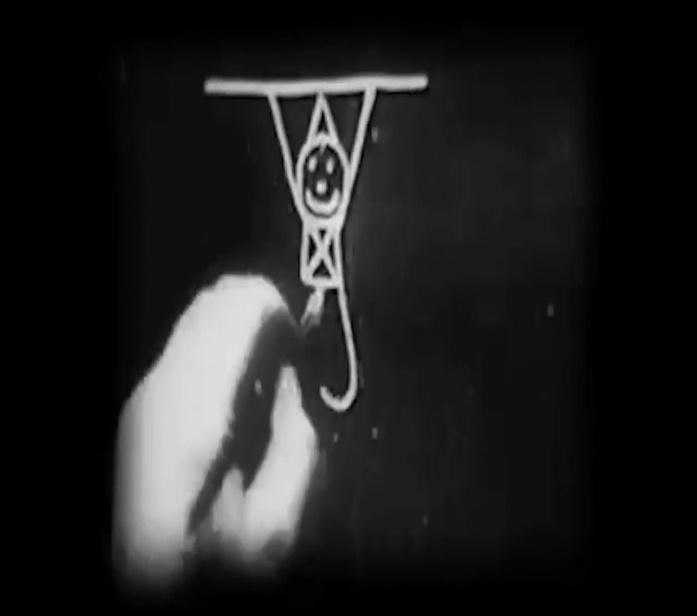
Figure 2
Cartoons are not meant only for sheer fun and behind each and every occurrence there should have the presence of a dialectical process and we cannot read cartoons without this process. Cartoons talk a lot and thus invites a discourse either positive or negative. Sometimes it is accepted by society and sometimes neglected and criticized. In spite of that the historical dominance of the culture of cartooning in society is unquestionable but also controversial. They can give birth to generous laughter as well as stark criticism. They have the ability to bring a smile to a depressed face and again they can snatch a smile from a boastful face. The significance of cartooning is enormous and at the same time, they can become bugs of disputes. As a result, we can easily figure out the dazzling presence of various types of cartoons but mainly divided in two: political and apolitical. A cartoon which forms a point about a political issue or event is called a political cartoon. It is an artistic creation decorated with satirical or metaphorical language. It includes the idea of social and educational reforms, social evils, political corruption, administrative loopholes, gender discrimination, communal riots, untouchability, national dis-integrity etc. Political cartoons can generate laughter only when one can realize the main issue on which the cartoonist is commenting. Again, political cartoons exhibit enough potential to help in opinion formation or decision making for a country. The cartoonist in a political cartoon presents things from his/ her own point of view and these cartoons have the power to convince people blindly about the cartoonist’s own point of view. For this reason, political cartoons are referred to as editorial cartoons. In this regard, the mind— the mind behind it and the mind which is going to accept it—is an important factor. If the mind is not prepared to accept the flavor of these cartoons, the creation is flopped. Cartoons are not a modern invention; history says that some rude and fractional portraits of some unpopular chieftains were at first drawn by men in the stone age. If we look at the American scenario, mention must be made of publisher and printer Benjamin Franklin, who was considered as the first American to draw political cartoons. This revolutionary figure drew several cartoons to inspire the colonists against the British imperialism. His wonderful creation is Join, or Die (Figure 3), a political cartoon in a woodcut showing a snake cut into eight pieces, with each part symbolizing one of the former American colonies or regions. The cartoon appeared along with Franklin’s editorial about ‘disunited states’ of the colonies and emphasized the idea of colonial unity. Cook writes, “The pictorial imagery in the snake cartoon incorporates several symbolic themes whose combined interpretation amplifies and reinforces the text: map, snake and dismemberment themes. In an investigation of Franklin’s sources, each theme warrants separate consideration” (93). The snake was so much meaningful that it was copied in many colonial newspapers and it was “repeatedly revived and its message adapted to new political circumstances: the Stamp Act crisis in the 1760s, the American Revolution in the 1770s and, finally, the American Civil War in the 1860s” (Cook 88).
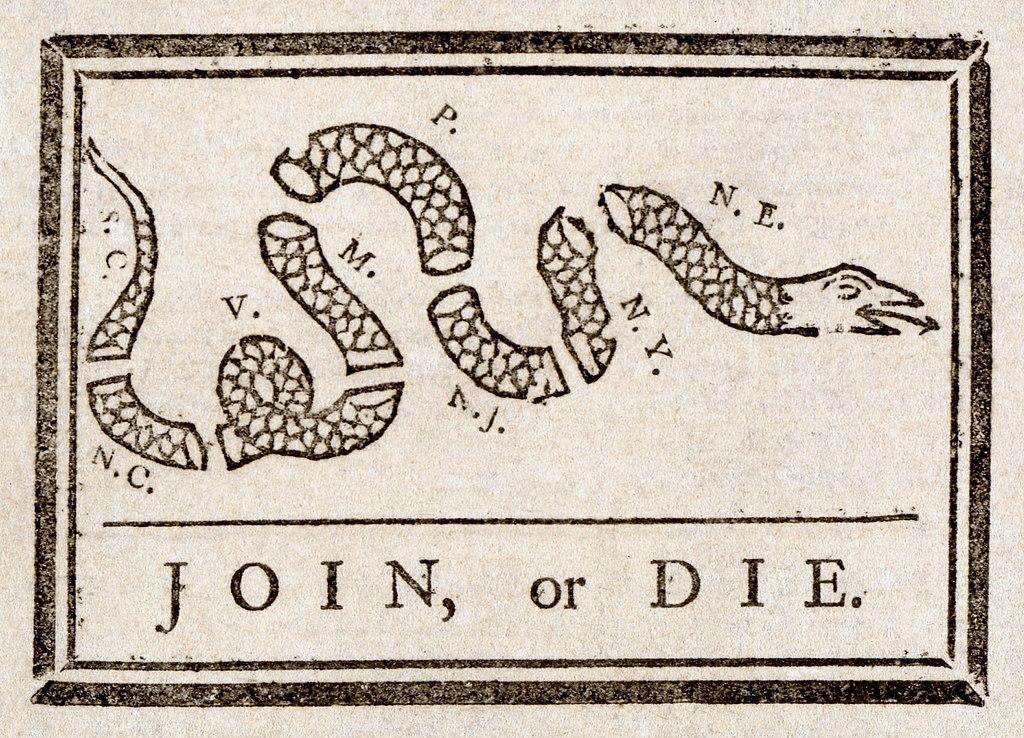
Figure 3
While talking about Indian political cartoonists, mention may be made of R. K. Laxman, Abu Abraham, Mario Miranda, Kutty, O. V. Vijayan. K. Shankar Pillai and others. Cartoonist, illustrator and humorist R. K. Laxman was best known for his creation of the ‘Common Man’ (Figure 5) which represented the hopes, problems, ambitions of the average Indian through his daily cartoon strip, You Said It in The Times of India. “Laxman is considered by many to be India’s most talented cartoonist” (Chatterjee 303). Again, Chatterjee mentions, “Even without any formal training in the art of cartooning, Laxman’s deft craftsmanship and style of humor have endeared him in the hearts of countless readers'' and she continues to say, “ Laxman’s cartoons are involved with and embedded in Indian political and social life” and “his cartoons comment on myriad aspects of Indian life, from general elections, economic liberalization, foreign policy decisions, corruption, and red-tapism to the dreary monotony of the common man’s life, which remains placidly unchanged despite the sensational changes occurring all around” (303). The following picture (Figure 4) is the eight feet bronze statue of ‘the common man’ which is situated in front of the Symbiosis Vishwabhavan building. It was installed in 2001 with the consent of R. K. Laxman and his wife Kamala.
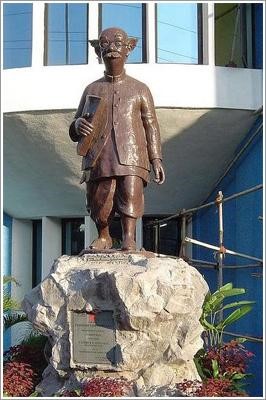
Figure 4
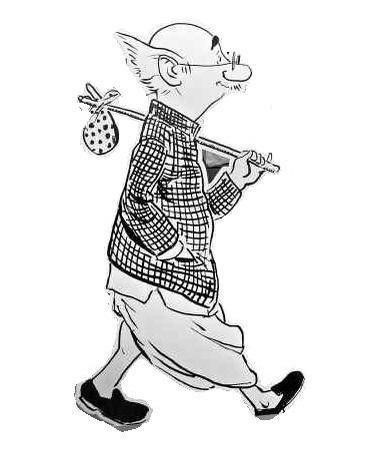
Figure 5
So far as it is known that political cartoons made their first appearance in the form of fetus in stone age and thereafter emerged other forms of political and apolitical cartoons. People of stone age used to draw on the walls of caves and by doing so they used to depict their views and opinions about certain issues. In modern times political cartoons are broadly used in newspapers, television, roadside hoardings, wall paintings, social media like Facebook, WhatsApp, Instagram, Twitter, etc. In this respect memes are also worth noting. Though political cartooning has world-wide popularity and it is one of the coolest ways to debunk ills of the figures in power, in many cases, the cartoonists become prey to the red eyes of the authority. Even s/he may be fired from their positions due to the fact that they have angered the authority. One example is the following (Figure 6) — “According to CBS News, Rogers was fired in June 2018 after working 25 years at the Pittsburgh Post-Gazette as their political cartoonist” (Mcginnis). The next one (Figure 7) represents the realistic picture of a country in a meaningful way.
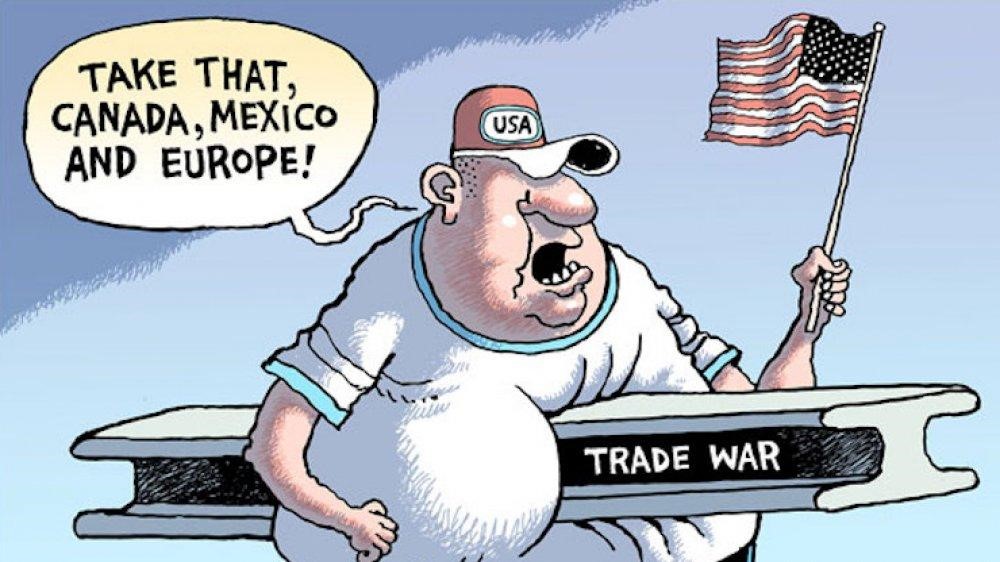
Figure 6
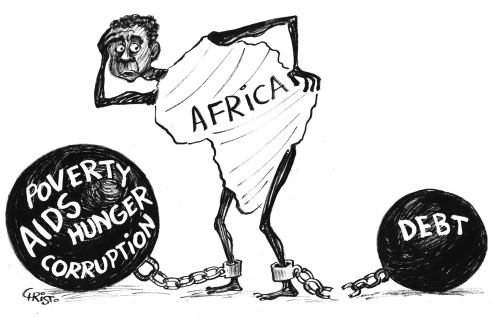
Figure 7
The modern political cartoons are visible in editorial pages of various newspapers and these are sometimes based on traditional visual metaphors and symbolic figures such as Uncle Sam, Republican elephant. Another popular type of political cartoon is pocket cartoon which was introduced by Osbert Lancaster in 1939 in the Daily Express; it typically consists of political jokes and appears as single-column drawing.
On the other hand, non-political/ apolitical cartoons, as the name itself suggests, is a type that is not related to politics and the purpose is only entertainment. While speaking about cartooning mention may be made of fresco painting of sixteenth century and the cartoons of Raphael and Leonardo da Vinci of seventeenth century and till now these cartoons are displayed in museums all over the world, but it was not until 1843 that the term ‘cartoon’ was used to denote anything but initial drawings for fine art. The modern usage of the term ‘cartoon’ was devised by British magazine Punch which was founded by Henry Mayhew and Ebenezer Landells and was popular for satirical sketches. A group of artists like John Tenniel, Richard Doyle, John Leech, Charles Keene, who was popularly known as ‘The Punch Brotherhood’ remained noteworthy contributors in Punch and later on Charles Dickens joined this group and all of them enriched another magazine Once A Week with their creative and artistic inputs. The following picture (Figure 8) is one of the significant contributions of Leonardo da Vinci that amazed all in his time and till now is an asset as an artistic creation. Varasi in his Lives appreciated this piece of art in his own artistic language, “Finally he made a cartoon of a Virgin and St. Anne with a Christ that not only amazed all artists, but, when it was finished was displayed in his room, where men and women, old and young, came to see it as if to a solemn celebration, in order to see the marvel of Leonardo that astonished the entire population” (qtd. in Wasserman 194).
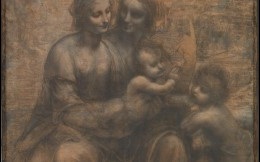
Figure 8
If we look at the twentieth and twenty-first century, we can see that cartooning has taken new dimensions. Comic strips or panels, gag cartoons, illustrative cartoons, animated cartoons are various types of apolitical cartoons. Modern gag cartoons are found in magazines, newspapers and greeting cards. James Thurber, Peter Arno, Gary Larson et.al. are famous as gag cartoonists. Comic strips are found daily in newspapers worldwide. They are named as ‘comics’ in the United States and in the United Kingdom, comic strips are known as ‘strip cartoons’, which are generally a short series of cartoon artworks in sequence. They appear daily in newspapers world-wide. The Adventures of Tintin is a popular TV series of twenty-four albums created by Belgian cartoonist Georges Remi who wrote under the pseudonym Hergé. It is one of the most popular comics of twentieth century Europe as it has won millions of hearts. One of the most common modern usages of the phrase ‘cartoon’ refers to animated television movies and short films. Though these are used in various animated presentations, mostly these are created for the enjoyment of the children depicting the enlivened demonstration of animals, superheroes, the venture of child protagonists and other related thematic issues. Winsor McCay, a renowned cartoonist, is celebrated as ‘the father’ of the animated cartoon after his invention of Gertie the Dinosaur, a milestone of animated cartoon which was produced in 1914 and was regarded as the first to “feature a character developed specifically for animation, and showed the true potential of the medium” (“Cartoon”). It would be unjust if we did not mention the name of Walt Disney, one of the pioneering figures in animation. The themes of his movies are joy, magic etc. and he presented through his animated movies the fairy tales, motivating stories for children. If we look at Indian scenario, we can find that nowadays children watch shows like Chhota Bheem, Superman, Spiderman, Tom and Jerry, Nonte Fonte and others. These television series are very popular among children. Many of the protagonists of these series also educate them how to use common sense and do things using their intellect. Children easily learn many things watching these animated figures rather than listening to valuable speeches because of the beautiful presentation of the stories.
However, while speaking about the comparative study of political and apolitical cartoons, we can easily figure out that it is the political cartoon that strongly and satirically attacks the current political events. Sometimes one political party uses political cartoons to create distance between their opponents and common people. This type of cartoons influences public sentiment and opinion and are used as tools for propaganda. Political cartoons are like capsules. They provide viewers with a slice of life of the time when they are created carrying with them the universal themes and practical aspect of life. They affect the mind of people with the use of irony, caricature, blending etc. Nevertheless, they are controversial; here one cries and another laughs. But in the sphere of apolitical cartoons, they are mainly created to fulfill the commercial purposes using modern technology. They are free from partiality as these attract a wide range of mass and sometimes teach the children various lessons in their life either good or bad depending mostly on imagination, colour combination and finally, presentation. Here the viewers always remain busy to enjoy the illustration/ picture to their heart's content. At present, we have entered into the era of globalization which has brought a dynamic change in every sphere of society. These sky-high technological developments have provided numerous attractive commodities. Human beings have become the prey to violent aggression of consumerism and involved in unequal dangerous competition. As a result, they are leading mechanical lives. Human qualities like patience and tolerance are now being erased. The place of criticism in politics is increasing. On the other hand, technological development has also brought unique changes in pattern and techniques in the world of cartooning. Now the artistic arrangements of cartoons in the practical field are earnestly required but the imaginations and the creations of the cartoonists are being restricted by the authoritarian trends, otherwise, they will suffer harsh blows.
Coming out of the argumentative session between political and apolitical cartoons, we must have a look at the most important fact, that is the ultimate goal of both political and apolitical cartoons — which is to evoke laughter and spread education and awareness among people. Laughter, an inseparable part of human life, gives contentment in a moment. In a cartoon, when an ant with a man's head tells a same type of grasshopper that they have spent their summer singing with delight and they should spend their winter also dancing merrily, a different type of feeling spontaneously sprung from the hearts of the viewers and it evokes a flow of laughter. Being tired in the busy professional life full of work and in the sultry atmosphere of the familial life, if one suddenly takes a glance of a cartoon in the newspaper, just at that very moment some waves of laughter become visible on his/her cloudy face. In a cartoon the finance minister has firmly taken the hold of a dragon symbolizing price hike. This cartoon is successful in evoking laughter removing the temporary cloudy atmosphere. In both societal and political spheres, the contribution of laughter is indisputable. To fulfill that objective in ancient times, the clowns were appointed in the royal courts. These clowns, using their equivocal languages, were successful in bringing some tints of laughter in the faces of kings making them forget their tiresome problems. Educated people also are not far away from enjoying the bliss of humour. They enjoy various humorous presentations in the comic books. Nowadays the mysterious and humorous activities of Gopal Bhar, the clown of king Krishnachandra or Birbal, the witty advisor of the court of Emperor Akbar have become the subjects of cartooning bringing the flow of laughter in both educated and uneducated society. In the history of art and culture of a country, the humourous and at the same time, artistic presentation plays a vital role to bring some relief from the monotonous journey of life. The readers and audiences are overwhelmed because of these humorous presentations. The ideas presented through cartoons become comprehensible to the audience easily and at the same time through the process of laughter various physiological movements occur in human beings.
To sum up our discussion we must focus on the fact that the creation of cartoons, an artistic activity, not only makes satirical attacks or entertains people, at the same time, it helps in the development of mass education, develops the process of mass communication and enhances mass awareness. A cartoon illustrating the fierce run of a father along with his 8/10 children not only evokes laughter in the minds of the viewers but also at the same time makes us aware of the problems generated from the population explosion. People become aware of this fact and try to find out the remedy of the problem. Human civilization demands development, more development and in the world of creativity there is ample scope of presenting things differently. No doubt, through this process, the technology of cartoons will be more enriched and will fulfill our expectation of enhancing a broad space for pure laughter in future allowing human society to enjoy stress free and exciting life.
References:
- “Cartoon”. New World Encyclopedia. Web. 20 Mar. 2021.
- Chatterjee, Sushmita. “Cartooning Democracy: The Images of R. K. Laxman”. Political science and Politics 40.2 (Apr. 2007): 303-306. JSTOR. Web. 14 Mar. 2021.
- Cook, Karen Saverud. “Benjamin Franklin and the Snake That Would Not Die”. The British Library Journal 22.1 (Spring 1996): 88-111. JSTOR. Web. 20 Mar. 2021.
- “Fantasmagorie, the World’s First Fully animated cartoon, Was Released on Aug 17, 1908”. India Today. 18 Aug. 2017. Web. 19 Mar. 2021.
- Gregory, J. C. “Some Theories of Laughter” Mind 32.127 (Jul. 1923): 328-344. JSTOR. Web. 14 Mar. 2021.
- Mcginnis, Brit. “Political Cartoons That Got People Fired”. Grunge. 3 Nov. 2019. Updated. 23 Dec, 2020. Web. 15 Mar. 2021.
- Sutton, Joseph. Ed. Words of Wellness: A Treasury of Quotations of Well-Being. Carson: Cronus Books, 1991. Google Book Search. Web. 13 Jan. 2020
- Wasserman, Jack. “A Re-Discovered Cartoon by Leonardo da Vinci”. The Burlington Magazine 112.805 (Apr. 1970): 194-204. JSTOR. Web. 15 Mar. 2021.
- Figure1: Cohl, Emile. Fantasmagorie. 1908. Wikipedia. Web. 13 Mar. 2021
- Figure 2: Cohl, Emile. Fantasmagorie. 1908. Web. 13 Mar. 2021
- Figure 3: Franklin, Benjamin. Join, or Die. 1754. Wikipedia. Web. 13 Mar. 2021
- Figure 4: “Common Man”. Symbiosis Society.
- Figure 5: Laxman, R. K. Common Man. N. d.
- Figure 6: Mcginnis, Brit. “Political Cartoons That Got People Fired”. Grunge. 3 Nov. 2019. Updated. 23 Dec, 2020. Web. 15 Mar. 2021.
- Figure 7: “Crying for Malawi”. Wise One from the East. May. 26 2013. Web. 15 Mar. 2021
- Figure 8: Vinci, Leonardo da. The Virgin and Child with Saint Anne and the Infant Saint John the Baptist (‘The Burlington House Cartoon’). 1499-1500. The National Gallery. UK. Web. 15 Mar. 2021